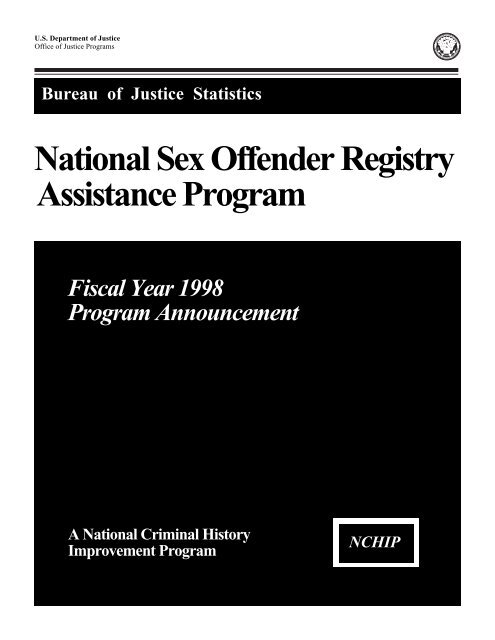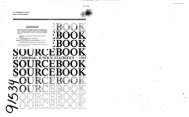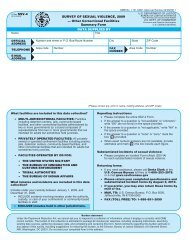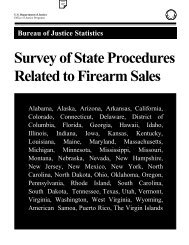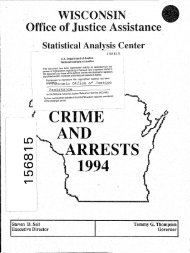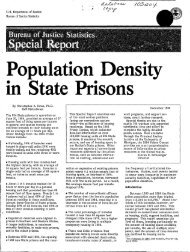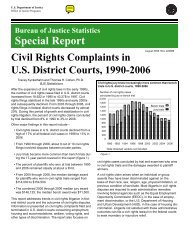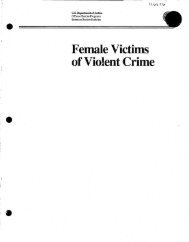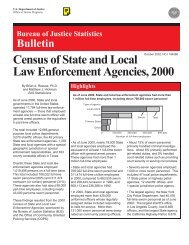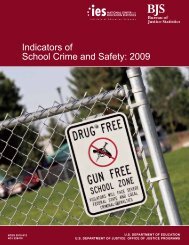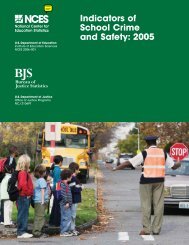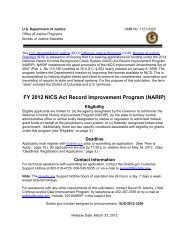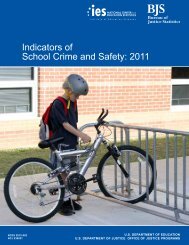National Sex Offender Registry Assistance Program - Bureau of ...
National Sex Offender Registry Assistance Program - Bureau of ...
National Sex Offender Registry Assistance Program - Bureau of ...
Create successful ePaper yourself
Turn your PDF publications into a flip-book with our unique Google optimized e-Paper software.
U.S. Department <strong>of</strong> Justice<strong>Bureau</strong> <strong>of</strong> Justice StatisticsJan M. Chaiken, Ph.D.DirectorContentsSummary 1<strong>Program</strong> goals 1Background 1Appropriation and assistance program 2Application and award process 2Timing 3Allocation <strong>of</strong> funds within the State 3Interface with the FBI's <strong>National</strong><strong>Sex</strong> <strong>Offender</strong> <strong>Registry</strong> system 3<strong>Program</strong> narrative 3Background 3Identification <strong>of</strong> needs 3<strong>Program</strong> description 4Coordination 4Timetable 4Fund allocation and budget 4Review and funding criteria 4Funding and allowable costs 5AppendixesA. Application and administrativerequirements 9B. Application forms 17ii <strong>National</strong> <strong>Sex</strong> <strong>Offender</strong> <strong>Registry</strong> <strong>Assistance</strong> <strong>Program</strong>
<strong>National</strong> <strong>Sex</strong> <strong>Offender</strong> <strong>Registry</strong> <strong>Assistance</strong> <strong>Program</strong> (NSOR-AP)Fiscal 1998 <strong>Program</strong> AnnouncementSummaryThe <strong>Bureau</strong> <strong>of</strong> Justice Statistics (BJS) is publishingthis notice to announce the establishment<strong>of</strong> the <strong>National</strong> <strong>Sex</strong> <strong>Offender</strong> <strong>Registry</strong><strong>Assistance</strong> <strong>Program</strong> (NSOR-AP) in Fiscal Year(FY) 1998. The NSOR <strong>Assistance</strong> <strong>Program</strong> is acomponent <strong>of</strong> the BJS <strong>National</strong> Criminal HistoryImprovement <strong>Program</strong> (NCHIP). Copies <strong>of</strong> thisannouncement also can be found on the Internetat http://www.ojp.usdoj.gov/bjs/.<strong>Program</strong> goalsThe BJS <strong>National</strong> <strong>Sex</strong> <strong>Offender</strong> <strong>Registry</strong> <strong>Assistance</strong><strong>Program</strong> (NSOR-AP) supports the President'sgoal <strong>of</strong> establishing an effective nationalregistry <strong>of</strong> convicted sex <strong>of</strong>fenders. This will ensurethat accurate and complete informationabout sex <strong>of</strong>fenders is appropriately made availableto protect the public and prevent furthervictimizations. Specifically, the program willhelp States ensure that:(1) State sex <strong>of</strong>fender registries identify, collect,and properly disseminate relevant informationthat is consistent, accurate, complete, andup-to-date;(2) States establish appropriate interfaces withthe FBI's national system so that State registryinformation on sex <strong>of</strong>fenders can be obtainedand tracked from one jurisdiction to another.BackgroundEstablishment <strong>of</strong> an effective national sex <strong>of</strong>fenderregistry that is capable <strong>of</strong> providing instantaccess to data on sex <strong>of</strong>fender location onan interstate basis is a national priority.In his Order dated June 25, 1996, PresidentClinton directed that Attorney General Renodevelop a plan for a national sex <strong>of</strong>fender registryby August 1996. In her response, submittedto the President on August 22, 1996, the AttorneyGeneral stressed the DOJ commitment toestablishment <strong>of</strong> a sex <strong>of</strong>fender registry and indicatedthat this goal would be achieved througha coordinated effort involving the FBI (theagency that will maintain and operate the <strong>National</strong><strong>Sex</strong> <strong>Offender</strong> <strong>Registry</strong>), the <strong>National</strong> LawEnforcement Telecommunications System(NLETS) (the system through which States willcommunicate registry information between andamong themselves and the FBI), and the States(which have primary responsibility for gatheringdata on sex <strong>of</strong>fenders for use within the Stateand input into the national system). In addition,subsequent amendments to 42 U.S.C. 14072require the establishment <strong>of</strong> such a registry andamendments to 42 U.S.C. 14071 require Statesto participate in the <strong>Registry</strong> as a condition <strong>of</strong>eligibility for full Byrne grant funding.The permanent <strong>National</strong> <strong>Sex</strong> <strong>Offender</strong> <strong>Registry</strong>File will be developed as part <strong>of</strong> the FBI'sNCIC-2000 project and will include a fingerprintand photo (mugshot) image <strong>of</strong> the registered<strong>of</strong>fender. The file will be a "hot file" and beaccessible to authorized users without submittingfingerprints. As reported in the AttorneyGeneral's August 1996 response to thePresident, the accelerated date for the permanentsystem to be in place is mid-1999.Pending establishment <strong>of</strong> the permanent system,an interim national pointer system hasbeen established by the FBI, that flags criminalhistory records <strong>of</strong> persons whom States identifyFiscal Year 1998 <strong>Program</strong> Announcement 1
as being registered as sex <strong>of</strong>fenders. This issimilar to the procedure used in the "Flash"system that identifies parolees and probationers.Inquiries that result in a "hit" identify theState registry that holds the full information onan <strong>of</strong>fender. Inquiring criminal justice agenciesmay use NLETS (or phone or paper) to requestmore detailed information. Flags are set basedon input from each <strong>of</strong> the States. As <strong>of</strong> March4, 1998, the FBI indicates that 23 States areproviding data to the interim system and that anestimated 31,590 records are currently flagged.Available information indicates that all Statesoperate some type <strong>of</strong> sex <strong>of</strong>fender registry atthis time. In order, however, for the nationalsystem to permit law enforcement in eachState to have information on <strong>of</strong>fenders initiallyreleased in other States, or traveling throughoutthe Nation, these individual registries must beautomated, accurate, and interfaced with thenational system on a timely basis.The BJS <strong>National</strong> <strong>Sex</strong> <strong>Offender</strong> <strong>Registry</strong> <strong>Assistance</strong><strong>Program</strong> (NSOR-AP) is designed to helpStates ensure that State sex <strong>of</strong>fender registriesidentify, collect, and properly disseminate relevantinformation that is consistent, accurate,complete and up-to-date. Additionally, the programwill help States establish appropriate interfaceswith the FBI's national system so thatState registry information on sex <strong>of</strong>fenders canbe obtained and tracked from one jurisdiction toanother.The BJS NSOR-AP program will also assistStates in meeting relevant requirements <strong>of</strong> currentFederal legislation (The Jacob WetterlingCrimes Against Children and <strong>Sex</strong>ually Violent<strong>Offender</strong> Registration Act, Megan's Law, andthe Pam Lychner <strong>Sex</strong>ual <strong>Offender</strong> Tracking andIdentification Act (42 U.S.C. 14071,14072), asamended by Section 115 <strong>of</strong> the general provisions<strong>of</strong> Title I <strong>of</strong> the Departments <strong>of</strong> Commerce,Justice, and State, the Judiciary andRelated Agencies Appropriation Act <strong>of</strong> 1998,P.L. 105-119) and applicable State standards.Appropriation and assistance programThe FY 1998 BJS appropriation includes $25million to support the national sex <strong>of</strong>fenderregistry. Funds will be awarded to States underthe BJS <strong>National</strong> <strong>Sex</strong> <strong>Offender</strong> <strong>Registry</strong> <strong>Assistance</strong><strong>Program</strong> (NSOR-AP), which is a discretionaryaward component <strong>of</strong> the overall BJS<strong>National</strong> Criminal History Improvement <strong>Program</strong>(NCHIP). All States will be eligible for an awardunder the NSOR-AP program.Application and award processOnly one application will be accepted from eachState. The application must be submitted by theagency designated by the Governor to administerthe NSOR assistance program. Where thedesignated agency is the same as the designatedNCHIP agency, a separate applicationmust be submitted for NSOR-AP funds andNCHIP funds. A State may choose to submit itsapplication as part <strong>of</strong> a multistate consortium orother entity. In such case, the applicationshould include a statement <strong>of</strong> commitment fromeach State and be signed by an individualdesignated by the Governor <strong>of</strong> each participatingState. The application should also indicatespecific responsibilities and include a separatebudget for each State.2 <strong>National</strong> <strong>Sex</strong> <strong>Offender</strong> <strong>Registry</strong> <strong>Assistance</strong> <strong>Program</strong>
TimingTo be eligible for 1998 NSOR-AP funds, anapplication must be submitted to BJS by April15, 1998.Awards normally will be for 12 months, althougha longer period can be approved with sufficientjustification. Project activity may be initiated afterJuly 1, 1998, but no later than September1998. In the event that an award is made beforeJuly 1, 1998, the applicant may request anearlier start up date. Applications must containan end date no later than December 31, 1999.Allocation <strong>of</strong> funds within the StateThe agency designated to apply for and receivethe NSOR-AP award may allocate the fundswithin the State consistent with State policy andgoals. Although it is anticipated that the majority<strong>of</strong> funds will be utilized at the State level todirectly support development <strong>of</strong> the State registryand interfaces with the national system,funds may be directed to local agencies requiringassistance in connection with, for example,input <strong>of</strong> data. States should be particularlyaware <strong>of</strong> the key role played by courts in development<strong>of</strong> registry information and <strong>of</strong> specialneeds <strong>of</strong> Indian tribes.Interface with the FBI's <strong>National</strong> <strong>Sex</strong><strong>Offender</strong> <strong>Registry</strong> systemRegular input to the FBI's national system is akey goal <strong>of</strong> this assistance program. Accordingly,States that are not currently submittinginformation to the FBI's national registry at thetime <strong>of</strong> their application for funding are encouragedto request funding to accomplish this goalby September 30, 1998. All applications musteither indicate that the State is alreadysubmitting information or specify the date(s) bywhich data will be provided to the FBI's interimand/or permanent system.<strong>Program</strong> narrativeIn addition to the requirements set forth inAppendix A, the <strong>National</strong> <strong>Sex</strong> <strong>Offender</strong> <strong>Registry</strong><strong>Assistance</strong> <strong>Program</strong> (NSOR-AP) applicationshould include the following parts.Part I. BackgroundThis section should include a short description<strong>of</strong> the status <strong>of</strong>, and plans for, those aspects <strong>of</strong>the State sex <strong>of</strong>fender registry that are necessaryfor understanding the application. In particular,the discussion should indicate whetherthe registry is automated in whole or in part anddescribe the process for data input and disseminationto law enforcement agencies within theState. The section should also indicate whetherdata is being sent electronically to the FBI andthe categories <strong>of</strong> persons eligible to access registrydata. Where funds are requested for fingerprintor mugshot equipment, the sectionshould indicate the status <strong>of</strong> fingerprint or mugshotcapability at the registry and among localagencies charged with data input. The applicantshould also indicate whether any coordinationarrangements exist with neighboring Statesor Indian tribes.Part II. Identification <strong>of</strong> needsThis section should identify those areas andproblems that the applicant State believesshould be addressed to upgrade the functioning<strong>of</strong> the State registry and its interface with thenational system, consistent with Federal andState legislative requirements.Fiscal Year 1998 <strong>Program</strong> Announcement 3
Part III. <strong>Program</strong> descriptionThis section should describe specific tasks to beundertaken with requested funds. Tasks to beundertaken should be listed in priority order,with intended impact, budget requirements, andestimated dates <strong>of</strong> completion. The applicationshould indicate the means by which each taskwill help the State achieve the goals <strong>of</strong> theprogram.Part IV. CoordinationTo ensure that the NSOR-AP program fully supportsthe President's goals and furthers theoverall DOJ efforts to establish a national sex<strong>of</strong>fender registry, BJS will closely coordinate theNSOR-AP program with relevant <strong>of</strong>fices withinthe Department <strong>of</strong> Justice, including the Office<strong>of</strong> Justice <strong>Program</strong>s and the FBI. Similar coordinationis expected between the State's agencyresponsible for the State sex <strong>of</strong>fender registryand other interested State and local agenciesand Indian tribes.To ensure coordination <strong>of</strong> Federal fundingefforts, the application should include informationon current awards or pending applicationsfor Federal funding to support activities forwhich funds are being requested in the currentNSOR-AP application. Where relevant, suchinformation should indicate the amount <strong>of</strong> theother award, the grantor agency, and theprogram purpose.Part V. TimetableThis section should set forth a timetable for alltasks proposed to be funded under the award.The section should also include a statementassuring that the State currently is submittingdata to the FBI national sex <strong>of</strong>fender registrysystem, or set forth a timetable by which sucha link will be effectuated.Part VI. Fund allocation and budgetThis section should identify the agencies or governmentalcomponents that will receive fundsunder the award. In particular, the applicationshould specify the level <strong>of</strong> funds or other benefitswhich will be directed for the courts or Indiantribes. The application should identify thoseagencies to receive funds under the award andindicate the fiscal arrangements to accomplishfund transfer if the recipient agency is not theimplementing agency. The budget should providedetails for expenses in required categories(see Appendix A, Application Content). Pleasenote that allocation <strong>of</strong> funds to other State andlocal agencies is considered a contractual arrangementunder Federal budgeting categories.Review and funding criteriaStates should understand that full fundingmay not be possible for all proposed activities.Allocation <strong>of</strong> funds will be based on the amountrequested and the following factors:1) the extent to which proposed tasks willensure that the applicant State becomes afully functional part <strong>of</strong> the FBI's <strong>National</strong> <strong>Sex</strong><strong>Offender</strong> <strong>Registry</strong>;2) the extent to which activities to be supportedunder the award will, by virtue <strong>of</strong> the number <strong>of</strong>sex <strong>of</strong>fenders in the State, the level <strong>of</strong> technical4 <strong>National</strong> <strong>Sex</strong> <strong>Offender</strong> <strong>Registry</strong> <strong>Assistance</strong> <strong>Program</strong>
development in the State, geographic or demographicfactors, current operating proceduresand requirements, or other related factors, beexpected to have a major impact on availability<strong>of</strong> information about sex <strong>of</strong>fenders, both withinthe State and nationally;3) the proposed use or enhancement <strong>of</strong> innovativeprocedures that may be <strong>of</strong> value to otherjurisdictions;4) the technical feasibility <strong>of</strong> the proposal andthe extent to which the proposal appears reasonablein light <strong>of</strong> the State's current level <strong>of</strong>system development and statutory framework;5) reasonableness <strong>of</strong> the budget;6) nature <strong>of</strong> the proposed expenditures;7) the reasonableness <strong>of</strong> the relationship betweenthe proposed activities and the currentstatus <strong>of</strong> the State system in terms <strong>of</strong> technicaldevelopment, legislation, current fiscal demandsand future operating costs.Funding and allowable costsFunds may be used for the following purposes:1. Automate and enhance automation <strong>of</strong>registries. Funds may be used to automateand/or upgrade the automation <strong>of</strong> the State sex<strong>of</strong>fender registry. Eligible costs also includeautomating linkage between the registry and lawenforcement agencies within the State, anddeveloping and implementing procedures totransfer information to the FBI. Funds may onlybe used for procedures that are compatible withthe FBI system.2. Improve online access for law enforcementacross the State. Funds may be used tocreate linkage with local radio dispatchers orcomputerized methods <strong>of</strong> dissemination as amean <strong>of</strong> providing timely access to registry datato <strong>of</strong>ficers in the field. Funds may not be usedfor purchase <strong>of</strong> individual equipment to be usedby law enforcement <strong>of</strong>ficers in the field.3. Support automated input from courts,corrections, and other agencies and entitiesresponsible for transmitting registry data.Funds may be used to automate and developprocedures for automated transmission <strong>of</strong> datafrom courts, correctional agencies, and otherresponsible agencies and entities to the registry.This may entail direct transfer <strong>of</strong> funds to thesecomponents <strong>of</strong> the criminal justice system. Allowablecosts may include in-house automation,but only to the extent that such efforts are directlyrelated to the transmission <strong>of</strong> sex <strong>of</strong>fenderdata to the registry. Where funds are requestedfor automation <strong>of</strong> court, correctional, or otherrecords, the application should indicate the proportion<strong>of</strong> activity related to the identificationand/or transmission <strong>of</strong> records for use in the sex<strong>of</strong>fender registry.4. Develop procedures and s<strong>of</strong>twareto permit automated input to interimor permanent FBI system. Funds may beused for hardware, s<strong>of</strong>tware, and development,implementation, and training in proceduresto support automated input to the FBI's interimor permanent sex <strong>of</strong>fender registry system.5. Develop procedures and provide appropriatetraining to persons responsible forinputting data (including registrants).Funds may be used to purchase equipmentand develop/implement technical procedures t<strong>of</strong>acilitate initial or subsequent registration <strong>of</strong>Fiscal Year 1998 <strong>Program</strong> Announcement 5
<strong>of</strong>fenders. Funds may also be used to developprocedures and train personnel to ensure thatcomplete information is inputted to the systemon a timely basis. Funds may also be used todevelop procedures to advise registrants <strong>of</strong> reportingresponsibilities and to establish and implementprotocols for them to fulfill thisrequirement.6. Purchase automated fingerprint equipmentand develop procedures and protocols.Funds may be used to purchaseequipment, develop procedures, and implementprotocols for fingerprinting registrants entering aState system from another jurisdiction (or whereotherwise not identifiable within the State).This may include purchase <strong>of</strong> livescan equipmentfor local agencies. Where funds are to beused for this purpose, the application shoulddemonstrate that funds can be justified on thebasis <strong>of</strong> geographic, population, traffic or otherrelated factors. Livescan can only be purchasedwhere the State has established anAutomated Fingerprint Identification System(AFIS) and either has implemented or is implementingprocedures to ensure that the AFIS iscompatible with FBI standards.7. Establish mugshot identification capability.Funds may be used for purchase <strong>of</strong> equipmentand development/implementation <strong>of</strong>procedures to include mugshots <strong>of</strong> registrantsfor use either within the State or for transmissionto the FBI at such time as that capabilitybecomes available. Mugshots support communitynotification and law enforcement use <strong>of</strong> theregistry as a tool for identification and apprehension<strong>of</strong> suspects. States requesting funds forthis use must justify the location <strong>of</strong> the equipmentin terms <strong>of</strong> geography, population, traffic,and demography and ensure that equipment tobe used at the local or county level includes thecapability for transmission <strong>of</strong> images to theregistry for use throughout the State. Allequipment and s<strong>of</strong>tware purchased or developedwith funds under the award must becompatible with FBI standards.8. Review existing records (both manual andautomated) to identify previously convictedindividuals for inclusion in the registryand/or to develop flagging s<strong>of</strong>tware toidentify qualifying criminal history records.Where consistent with State legislation, fundsmay be used for review <strong>of</strong> existing records toidentify, flag, and transmit data from records <strong>of</strong>previously released <strong>of</strong>fenders who qualify forinclusion in the registry. This may include areview <strong>of</strong> juvenile records where consistent withState law or practice.9. Establish operating procedures to ensurethat data in the registries are accurate andcomplete. In order for the national registry tobe reliable and beneficial to the law enforcementcommunity, data submitted from Statesmust be both accurate and complete. Fundsmay be used to ⎯⎯ develop and implement procedures ands<strong>of</strong>tware⎯ provide relevant training⎯ ensure that changes in status are recordedand transmitted to the FBI⎯ ensure that both the State data and the dataat the FBI are accurate, up to date andcomplete.10. Evaluate, audit, provide training, andparticipate at national/regional/local conferencesand training sessions. Funds maybe used to audit or evaluate current operationsor needs, in order to identify necessary systemenhancements and/or modifications. Fundsmay also be used to prepare statistics on6 <strong>National</strong> <strong>Sex</strong> <strong>Offender</strong> <strong>Registry</strong> <strong>Assistance</strong> <strong>Program</strong>
transactions to and from the registry, utilizationpatterns, or any related information. Statesmust agree to cooperate with BJS and DOJsupported evaluation efforts and with statisticalanalysis conducted pursuant to other awardsmade by BJS. Where necessary, funds may beused to meet this requirement.Funds may also be used to sponsor trainingprograms to support registry operations andto send up to two representatives to twoworkshops/meetings/conferences focusing onoperation <strong>of</strong> the State or national sex <strong>of</strong>fenderregistry. Additional funds may be used tosupport additional participation at meetingswith prior BJS approval.11. Make registry data available for backgroundchecks or other authorizedpurposes. Funds may be used to purchaseequipment and develop s<strong>of</strong>tware to permit thedisclosure <strong>of</strong> registry data in connection withbackground checks or other purposes asauthorized by State or Federal legislation.The program does not require either "hard"(cash) or "s<strong>of</strong>t" (in-kind) matching funds. Indications<strong>of</strong> State support, however, may be interpretedas expressions <strong>of</strong> commitment by theState to the program. Additionally, all applicantsmust agree to participate in evaluations sponsoredby the Federal Government. The NSOR-AP program is intended to support the nationalsex <strong>of</strong>fender registry by assisting States to developand enhance State registries that feedinto the national system. Costs <strong>of</strong> regular operatingexpenditures are not, therefore, coveredunder the program.Fiscal Year 1998 <strong>Program</strong> Announcement 7
Appendix AApplication and administrative requirementsApplication contentAll applicants must submit:Standard Form 424, Application for Federal<strong>Assistance</strong>Budget Detail Worksheet (replaced theSF 424A, Budget Information)OJP Form 4000/3 (Rev. 1-93), <strong>Program</strong>Narrative and AssurancesOJP Form 4061/6 Certification RegardingLobbying; Debarment, Suspension, and OtherResponsibility Matters; Drug-Free WorkplaceRequirements.OJP Form 7120/1 (Rev. 1-93), AccountingSystem and Financial Capability Questionnaire(to be submitted by applicants who have notpreviously received Federal funds).Applicants are requested to submit an originaland two copies <strong>of</strong> the application and certificationsto the following address:Application Coordinator<strong>Bureau</strong> <strong>of</strong> Justice Statistics810 Seventh Street, N.W.Washington, DC 20531Phone: (202) 616-3500Standard Form 424 (SF-424). The SF-424,a one-page sheet with 18 items, serves as acover sheet for the entire application. This formis required for every application for Federalassistance. NO APPLICATION CAN BEACCEPTED WITHOUT A COMPLETED,SIGNED ORIGINAL SF-424. Directions tocomplete each item are included on the back<strong>of</strong> the form.Budget detail worksheet. Applicants mustprovide a detailed justification for all costs,including the basis for computation <strong>of</strong> thesecosts. For example, the detailed budget wouldinclude the salaries <strong>of</strong> staff involved in theproject and the portion <strong>of</strong> those salaries to bepaid from the award; fringe benefits paid to eachstaff person; travel costs related to the project;equipment to be purchased with the awardfunds; and supplies required to complete theproject.Budget narrative. The budget narrative shoulddetail costs included in each budget category forthe Federal and the non-Federal (in-kind andcash) share. The purpose <strong>of</strong> the budget narrativeis to relate items budgeted to project activitiesand to provide justification and explanationfor budget items, including criteria and dataused to arrive at the estimates for each budgetcategory. The budget narrative should also indicateamounts to be made available to agenciesother than the grant recipient (for example,the agency with responsibility for ComputerizedCriminal History (CCH) records, the courts, localagencies.) The following information is providedto assist the applicant in developing the budgetnarrative.a. Personnel category. List each position bytitle (and name <strong>of</strong> employee if available), showannual salary rate and percentage <strong>of</strong> time to bedevoted to the project by the employee. Compensationpaid for employees engaged in federallyassisted activities must be consistent withthat paid for similar work in other activities <strong>of</strong> theapplicant.b. Fringe benefits category. Indicate each type<strong>of</strong> benefit included and explain how the totalcost allowable for employees assigned to theproject is computed.<strong>National</strong> <strong>Sex</strong> <strong>Offender</strong> <strong>Registry</strong> <strong>Assistance</strong> <strong>Program</strong> 11
c. Travel category. Itemize travel expenses <strong>of</strong>project personnel by purpose (e.g., faculty totraining site, field interviews, advisory groupmeetings, etc.) and show basis or computation(e.g., "Five trips for x purpose at $80 averagecost--$50 transportation and two days per diemat $15" or "Six people to 30-day meeting at $70transportation and $45 subsistence.") In trainingprojects where travel and subsistence fortrainees is included, this should be separatelylisted indicating the number <strong>of</strong> trainees and theunit costs involved.(1) Identify the tentative location <strong>of</strong> alltraining sessions, meetings, and other travel.(2) Applicants should consult such referencesas the Official Airline Guide and the Hoteland Motel Redbook in projecting travel costs toobtain competitive rates.d. Equipment. List each type <strong>of</strong> equipment tobe purchased or rented with unit or monthlycosts.e. Supplies. List items within this category bymajor type (<strong>of</strong>fice supplies, training materials,research forms, postage) and show basis forcomputation. Provide unit or monthly estimates.f. Contractual category. State the selectionbasis for any contract, subcontract, prospectivecontract, or prospective subcontract (includingconstruction services and equipment). Pleasenote applications that include noncompetitivecontracts for the provision <strong>of</strong> specific servicesmust contain a sole source justification for anyprocurement in excess <strong>of</strong> $100,000.For individuals to be reimbursed for personalservices on a fee basis, list by name or type <strong>of</strong>consultant or service, the proposed fee (by day,week, or hour) and the amounts <strong>of</strong> time to bedevoted to such services.For construction contracts and organization (includingpr<strong>of</strong>essional associations and educationinstitutions performing pr<strong>of</strong>essional services),indicate the type <strong>of</strong> service to be performed andthe estimated contract cost data.g. Construction category. Describe constructionor renovation that will be accomplishedusing grant funds and the method used to calculatecost.h. Other category. Include under "other" suchitems as rent, reproduction, telephone, and janitorialor security services. List items by majortype with basis <strong>of</strong> computation shown. (Providesquare footage and cost per square foot for rent⎯ provide local and long distance telephonecharges separately.)I. Indirect charges category. The Agency mayaccept an indirect cost rate previously approvedfor an applicant by a Federal agency. Applicantsmust enclose a copy <strong>of</strong> the approved rateagreement with the grant application.j. <strong>Program</strong> income. If applicable, provide a detailedestimate <strong>of</strong> the amount <strong>of</strong> program incometo be generated during the grant periodand its proposed application (to reduce the cost<strong>of</strong> the project or to increase the scope <strong>of</strong> theproject). Also, describe the source <strong>of</strong> programincome, listing the rental rates to be obtained,sale prices <strong>of</strong> publications supported by grantfunds, and registration fees charged for particularsessions. If scholarships (covering, for example,registration fees) are awarded by theorganization to certain conference attendees,the application should identify the percentage <strong>of</strong>12 Fiscal Year 1998 <strong>Program</strong> Announcement
all attendees that are projected as "scholarship"cases and the precise criteria for their selection.<strong>Program</strong> narrative. All applications must includea program narrative that fully describesthe expected design and implementation <strong>of</strong> theproposed program. OJP Form 4000/3 (Rev.1-93) provides additional detailed instructionsfor preparing the program narrative.The narrative should include a time line <strong>of</strong> activitiesindicating, for each proposed activity, theprojected duration <strong>of</strong> the activity, expected completiondate, and any products expected.The application should include a description <strong>of</strong>the roles and responsibilities <strong>of</strong> key organizationaland/or functional components involved inproject activities; and a list <strong>of</strong> key personnel responsiblefor managing and implementing themajor elements <strong>of</strong> the program.Assurances. OJP Form 4000/3 (Rev 1-93)must be included in the application submission.If submitting this form separate from theSF-424, the applicant must sign and date theform to certify compliance with the Federal statutes,regulations, and requirements as cited.Certification Regarding Lobbying; Debarment,Suspension, and Other ResponsibilityMatters; and Drug-Free Workplace. Applicantsshould refer to the regulations cited inOJP Form, 4061/6 to determine the certificationto which they are required to attest. A copy <strong>of</strong>OJP Form 4061/6 can be obtained from the BJSApplication Coordinator. Applicants should alsoreview the instructions for certification includedin the regulations before completing this form.Signature <strong>of</strong> this form provides for compliancewith certification requirements under 28 C.F.R.Part 69, "New Restrictions on Lobbying," and 28C.F.R. Part 67, "Government-wide Debarmentand Suspension (Nonprocurement) andGovernment-wide Requirements for Drug-FreeWorkplace (Grants)." The certifications shall betreated as a material representation <strong>of</strong> fact uponwhich reliance will be placed when the U.S.Department <strong>of</strong> Justice determines to award thecovered transaction, grant, or cooperativeagreement.Financial and administrative requirementsDiscretionary grants are governed by the provisions<strong>of</strong> OMB Circulars applicable to financialassistance. The circulars, in addition to the OJPFinancial Guide, are available from the Office <strong>of</strong>Justice <strong>Program</strong>s. This guideline manual is intendedto assist grantees in the administration<strong>of</strong> funds and includes information on allowablecosts, methods <strong>of</strong> payment, Federal rights <strong>of</strong>access to records, audit requirements, accountingsystems, and financial records.Complete and accurate information is requiredrelative to the application, expenditure <strong>of</strong> funds,and program performance. The consequences<strong>of</strong> failure to comply with program guidelines andrequirements will be determined at the discretion<strong>of</strong> the Department.Civil rights obligationsAll applicants for Federal financial assistancemust sign Certified Assurances that they are incompliance with the Federal laws and regulationswhich prohibit discrimination in any programor activity that receives such Federalfunds. Section 809(c), Omnibus Crime Control& Safe Streets Act <strong>of</strong> 1968, provides that ⎯No person in any State shall on the ground<strong>of</strong> race, color, religion, national origin, or<strong>National</strong> <strong>Sex</strong> <strong>Offender</strong> <strong>Registry</strong> <strong>Assistance</strong> <strong>Program</strong> 13
sex be excluded from participation in, bedenied the benefits <strong>of</strong>, or be subjected todiscrimination under, or denied employmentin connection with any program or activityfunded in whole or in part with funds madeavailable under this title.Section 504 <strong>of</strong> the Rehabilitation Act <strong>of</strong> 1973,and Title II <strong>of</strong> the Americans With DisabilitiesAct prohibit discrimination on the basis <strong>of</strong>disability.The applicant agency must discuss how it willensure nondiscriminatory practices as they relateto:(1) Delivery <strong>of</strong> services or benefits ⎯ to ensurethat individuals will not be denied access toservices or benefits under the program or activityon the basis <strong>of</strong> race, color, religion, nationalorigin, gender, age, or disability;(2) Employment practices ⎯ to ensure that itspersonnel in the program or activity are selectedfor employment without regard to race, color,religion, national origin, gender, age, or disability;and(3) <strong>Program</strong> participation ⎯ to ensure members<strong>of</strong> any planning, steering or advisory board,which is an integral part <strong>of</strong> the program or activity,are not excluded from participation on thebasis <strong>of</strong> race, color, religion, national origin,gender, age or disability; and to encourage theselection <strong>of</strong> such members who are reflective <strong>of</strong>the diversity in the community to be served.Audit requirementIn October 1984, Congress passed the SingleAudit Act <strong>of</strong> 1984. On April 12, 1985, the Office<strong>of</strong> Management and Budget issued CircularA-128, "Audits <strong>of</strong> State and Local Governments"which establishes regulations to implement theAct. OMB Circular A-128, "Audits <strong>of</strong> State andLocal Governments," outlines the requirementsfor organizational audits which apply to BJSgrantees.Disclosure <strong>of</strong> Federal participationSection 8136 <strong>of</strong> the Department <strong>of</strong> Defense AppropriationsAct (Stevens Amendment), enactedin October 1988, requires that, "when issuingstatements, press releases for proposals, bidsolicitations, and other documents describingprojects or programs funded in whole or in partwith Federal money, all grantees receiving Federalfunds, including but not limited to State andlocal governments, shall clearly state ⎯(1) the percentage <strong>of</strong> the total cost <strong>of</strong> theprogram or project which will be financedwith Federal money, and(2) the dollar amount <strong>of</strong> Federal funds for theproject or program."14 Fiscal Year 1998 <strong>Program</strong> Announcement
Intergovernmental review <strong>of</strong> Federal programsFederal Executive Order 12372, "IntergovernmentalReview <strong>of</strong> Federal <strong>Program</strong>s," allowsStates to establish a process for reviewing Federalprograms in the State, to choose which programsthey wish to review, to conduct suchreviews, and to make their views known to thefunding Federal agency through a State "singlepoint <strong>of</strong> contact."If the State has established a "single point <strong>of</strong>contact," and if the State has selected this programto be included in its review process, theapplicant must send a copy <strong>of</strong> its letter or applicationto the State "single point <strong>of</strong> contact" atthe same time that it is submitted to BJS. Theletter or application submitted to BJS must indicatethat this has been done. The State mustcomplete its review within 60 days. The reviewperiod will begin on the date that the letter orapplication is <strong>of</strong>ficially received by BJS. If BJSdoes not receive comments from the State's"single point <strong>of</strong> contact" by the end <strong>of</strong> the reviewperiod, this will be interpreted as a "no comment"response.If the State has not established a "single point <strong>of</strong>contact," or if it has not selected the BJS statisticsdevelopment or criminal history improvementprograms in its review process, this mustbe stated in the letter or application.<strong>National</strong> <strong>Sex</strong> <strong>Offender</strong> <strong>Registry</strong> <strong>Assistance</strong> <strong>Program</strong> 15
Appendix BApplication forms
Appendix AApplication and administrative requirementsApplication contentAll applicants must submit:Standard Form 424, Application for Federal<strong>Assistance</strong>Budget Detail Worksheet (replaced theSF 424A, Budget Information)OJP Form 4000/3 (Rev. 1-93), <strong>Program</strong>Narrative and AssurancesOJP Form 4061/6 Certification RegardingLobbying; Debarment, Suspension, and OtherResponsibility Matters; Drug-Free WorkplaceRequirements.OJP Form 7120/1 (Rev. 1-93), AccountingSystem and Financial Capability Questionnaire(to be submitted by applicants who have notpreviously received Federal funds).Applicants are requested to submit an originaland two copies <strong>of</strong> the application and certificationsto the following address:Application Coordinator<strong>Bureau</strong> <strong>of</strong> Justice Statistics810 Seventh Street, N.W.Washington, DC 20531Phone: (202) 616-3500Standard Form 424 (SF-424). The SF-424,a one-page sheet with 18 items, serves as acover sheet for the entire application. This formis required for every application for Federalassistance. NO APPLICATION CAN BEACCEPTED WITHOUT A COMPLETED,SIGNED ORIGINAL SF-424. Directions tocomplete each item are included on the back<strong>of</strong> the form.Budget detail worksheet. Applicants mustprovide a detailed justification for all costs,including the basis for computation <strong>of</strong> thesecosts. For example, the detailed budget wouldinclude the salaries <strong>of</strong> staff involved in theproject and the portion <strong>of</strong> those salaries to bepaid from the award; fringe benefits paid to eachstaff person; travel costs related to the project;equipment to be purchased with the awardfunds; and supplies required to complete theproject.Budget narrative. The budget narrative shoulddetail costs included in each budget category forthe Federal and the non-Federal (in-kind andcash) share. The purpose <strong>of</strong> the budget narrativeis to relate items budgeted to project activitiesand to provide justification and explanationfor budget items, including criteria and dataused to arrive at the estimates for each budgetcategory. The budget narrative should also indicateamounts to be made available to agenciesother than the grant recipient (for example,the agency with responsibility for ComputerizedCriminal History (CCH) records, the courts, localagencies.) The following information is providedto assist the applicant in developing the budgetnarrative.a. Personnel category. List each position bytitle (and name <strong>of</strong> employee if available), showannual salary rate and percentage <strong>of</strong> time to bedevoted to the project by the employee. Compensationpaid for employees engaged in federallyassisted activities must be consistent withthat paid for similar work in other activities <strong>of</strong> theapplicant.b. Fringe benefits category. Indicate each type<strong>of</strong> benefit included and explain how the totalcost allowable for employees assigned to theproject is computed.<strong>National</strong> <strong>Sex</strong> <strong>Offender</strong> <strong>Registry</strong> <strong>Assistance</strong> <strong>Program</strong> 11
c. Travel category. Itemize travel expenses <strong>of</strong>project personnel by purpose (e.g., faculty totraining site, field interviews, advisory groupmeetings, etc.) and show basis or computation(e.g., "Five trips for x purpose at $80 averagecost--$50 transportation and two days per diemat $15" or "Six people to 30-day meeting at $70transportation and $45 subsistence.") In trainingprojects where travel and subsistence fortrainees is included, this should be separatelylisted indicating the number <strong>of</strong> trainees and theunit costs involved.(1) Identify the tentative location <strong>of</strong> alltraining sessions, meetings, and other travel.(2) Applicants should consult such referencesas the Official Airline Guide and the Hoteland Motel Redbook in projecting travel costs toobtain competitive rates.d. Equipment. List each type <strong>of</strong> equipment tobe purchased or rented with unit or monthlycosts.e. Supplies. List items within this category bymajor type (<strong>of</strong>fice supplies, training materials,research forms, postage) and show basis forcomputation. Provide unit or monthly estimates.f. Contractual category. State the selectionbasis for any contract, subcontract, prospectivecontract, or prospective subcontract (includingconstruction services and equipment). Pleasenote applications that include noncompetitivecontracts for the provision <strong>of</strong> specific servicesmust contain a sole source justification for anyprocurement in excess <strong>of</strong> $100,000.For individuals to be reimbursed for personalservices on a fee basis, list by name or type <strong>of</strong>consultant or service, the proposed fee (by day,week, or hour) and the amounts <strong>of</strong> time to bedevoted to such services.For construction contracts and organization (includingpr<strong>of</strong>essional associations and educationinstitutions performing pr<strong>of</strong>essional services),indicate the type <strong>of</strong> service to be performed andthe estimated contract cost data.g. Construction category. Describe constructionor renovation that will be accomplishedusing grant funds and the method used to calculatecost.h. Other category. Include under "other" suchitems as rent, reproduction, telephone, and janitorialor security services. List items by majortype with basis <strong>of</strong> computation shown. (Providesquare footage and cost per square foot for rent⎯ provide local and long distance telephonecharges separately.)I. Indirect charges category. The Agency mayaccept an indirect cost rate previously approvedfor an applicant by a Federal agency. Applicantsmust enclose a copy <strong>of</strong> the approved rateagreement with the grant application.j. <strong>Program</strong> income. If applicable, provide a detailedestimate <strong>of</strong> the amount <strong>of</strong> program incometo be generated during the grant periodand its proposed application (to reduce the cost<strong>of</strong> the project or to increase the scope <strong>of</strong> theproject). Also, describe the source <strong>of</strong> programincome, listing the rental rates to be obtained,sale prices <strong>of</strong> publications supported by grantfunds, and registration fees charged for particularsessions. If scholarships (covering, for example,registration fees) are awarded by theorganization to certain conference attendees,the application should identify the percentage <strong>of</strong>Fiscal Year 1998 <strong>Program</strong> Announcement 12
all attendees that are projected as "scholarship"cases and the precise criteria for their selection.<strong>Program</strong> narrative. All applications must includea program narrative that fully describesthe expected design and implementation <strong>of</strong> theproposed program. OJP Form 4000/3 (Rev.1-93) provides additional detailed instructionsfor preparing the program narrative.The narrative should include a time line <strong>of</strong> activitiesindicating, for each proposed activity, theprojected duration <strong>of</strong> the activity, expected completiondate, and any products expected.The application should include a description <strong>of</strong>the roles and responsibilities <strong>of</strong> key organizationaland/or functional components involved inproject activities; and a list <strong>of</strong> key personnel responsiblefor managing and implementing themajor elements <strong>of</strong> the program.Assurances. OJP Form 4000/3 (Rev 1-93)must be included in the application submission.If submitting this form separate from theSF-424, the applicant must sign and date theform to certify compliance with the Federal statutes,regulations, and requirements as cited.Certification Regarding Lobbying; Debarment,Suspension, and Other ResponsibilityMatters; and Drug-Free Workplace. Applicantsshould refer to the regulations cited inOJP Form, 4061/6 to determine the certificationto which they are required to attest. A copy <strong>of</strong>OJP Form 4061/6 can be obtained from the BJSApplication Coordinator. Applicants should alsoreview the instructions for certification includedin the regulations before completing this form.Signature <strong>of</strong> this form provides for compliancewith certification requirements under 28 C.F.R.Part 69, "New Restrictions on Lobbying," and 28C.F.R. Part 67, "Government-wide Debarmentand Suspension (Nonprocurement) andGovernment-wide Requirements for Drug-FreeWorkplace (Grants)." The certifications shall betreated as a material representation <strong>of</strong> fact uponwhich reliance will be placed when the U.S.Department <strong>of</strong> Justice determines to award thecovered transaction, grant, or cooperativeagreement.Financial and administrative requirementsDiscretionary grants are governed by the provisions<strong>of</strong> OMB Circulars applicable to financialassistance. The circulars, in addition to the OJPFinancial Guide, are available from the Office <strong>of</strong>Justice <strong>Program</strong>s. This guideline manual is intendedto assist grantees in the administration<strong>of</strong> funds and includes information on allowablecosts, methods <strong>of</strong> payment, Federal rights <strong>of</strong>access to records, audit requirements, accountingsystems, and financial records.Complete and accurate information is requiredrelative to the application, expenditure <strong>of</strong> funds,and program performance. The consequences<strong>of</strong> failure to comply with program guidelines andrequirements will be determined at the discretion<strong>of</strong> the Department.Civil rights obligationsAll applicants for Federal financial assistancemust sign Certified Assurances that they are incompliance with the Federal laws and regulationswhich prohibit discrimination in any programor activity that receives such Federalfunds. Section 809(c), Omnibus Crime Control& Safe Streets Act <strong>of</strong> 1968, provides that ⎯No person in any State shall on the ground<strong>of</strong> race, color, religion, national origin, or<strong>National</strong> <strong>Sex</strong> <strong>Offender</strong> <strong>Registry</strong> <strong>Assistance</strong> <strong>Program</strong> 13
sex be excluded from participation in, bedenied the benefits <strong>of</strong>, or be subjected todiscrimination under, or denied employmentin connection with any program or activityfunded in whole or in part with funds madeavailable under this title.Section 504 <strong>of</strong> the Rehabilitation Act <strong>of</strong> 1973,and Title II <strong>of</strong> the Americans With DisabilitiesAct prohibit discrimination on the basis <strong>of</strong>disability.The applicant agency must discuss how it willensure nondiscriminatory practices as they relateto:(1) Delivery <strong>of</strong> services or benefits ⎯ to ensurethat individuals will not be denied access toservices or benefits under the program or activityon the basis <strong>of</strong> race, color, religion, nationalorigin, gender, age, or disability;(2) Employment practices ⎯ to ensure that itspersonnel in the program or activity are selectedfor employment without regard to race, color,religion, national origin, gender, age, or disability;and(3) <strong>Program</strong> participation ⎯ to ensure members<strong>of</strong> any planning, steering or advisory board,which is an integral part <strong>of</strong> the program or activity,are not excluded from participation on thebasis <strong>of</strong> race, color, religion, national origin,gender, age or disability; and to encourage theselection <strong>of</strong> such members who are reflective <strong>of</strong>the diversity in the community to be served.Audit requirementIn October 1984, Congress passed the SingleAudit Act <strong>of</strong> 1984. On April 12, 1985, the Office<strong>of</strong> Management and Budget issued CircularA-128, "Audits <strong>of</strong> State and Local Governments"which establishes regulations to implement theAct. OMB Circular A-128, "Audits <strong>of</strong> State andLocal Governments," outlines the requirementsfor organizational audits which apply to BJSgrantees.Disclosure <strong>of</strong> Federal participationSection 8136 <strong>of</strong> the Department <strong>of</strong> Defense AppropriationsAct (Stevens Amendment), enactedin October 1988, requires that, "when issuingstatements, press releases for proposals, bidsolicitations, and other documents describingprojects or programs funded in whole or in partwith Federal money, all grantees receiving Federalfunds, including but not limited to State andlocal governments, shall clearly state ⎯(1) the percentage <strong>of</strong> the total cost <strong>of</strong> theprogram or project which will be financedwith Federal money, and(2) the dollar amount <strong>of</strong> Federal funds for theproject or program."14 Fiscal Year 1998 <strong>Program</strong> Announcement
Intergovernmental review <strong>of</strong> Federal programsFederal Executive Order 12372, "IntergovernmentalReview <strong>of</strong> Federal <strong>Program</strong>s," allowsStates to establish a process for reviewing Federalprograms in the State, to choose which programsthey wish to review, to conduct suchreviews, and to make their views known to thefunding Federal agency through a State "singlepoint <strong>of</strong> contact."If the State has established a "single point <strong>of</strong>contact," and if the State has selected this programto be included in its review process, theapplicant must send a copy <strong>of</strong> its letter or applicationto the State "single point <strong>of</strong> contact" atthe same time that it is submitted to BJS. Theletter or application submitted to BJS must indicatethat this has been done. The State mustcomplete its review within 60 days. The reviewperiod will begin on the date that the letter orapplication is <strong>of</strong>ficially received by BJS. If BJSdoes not receive comments from the State's"single point <strong>of</strong> contact" by the end <strong>of</strong> the reviewperiod, this will be interpreted as a "no comment"response.If the State has not established a "single point <strong>of</strong>contact," or if it has not selected the BJS statisticsdevelopment or criminal history improvementprograms in its review process, this mustbe stated in the letter or application.<strong>National</strong> <strong>Sex</strong> <strong>Offender</strong> <strong>Registry</strong> <strong>Assistance</strong> <strong>Program</strong> 15
Appendix BApplication formsThe Application forms are not included in thisfile. Applications for NCHIP grants areaccepted only from the single State agencythat is designated by the Governor to coordinatethe distribution <strong>of</strong> funds within the State.The due date is April 15, 1998


